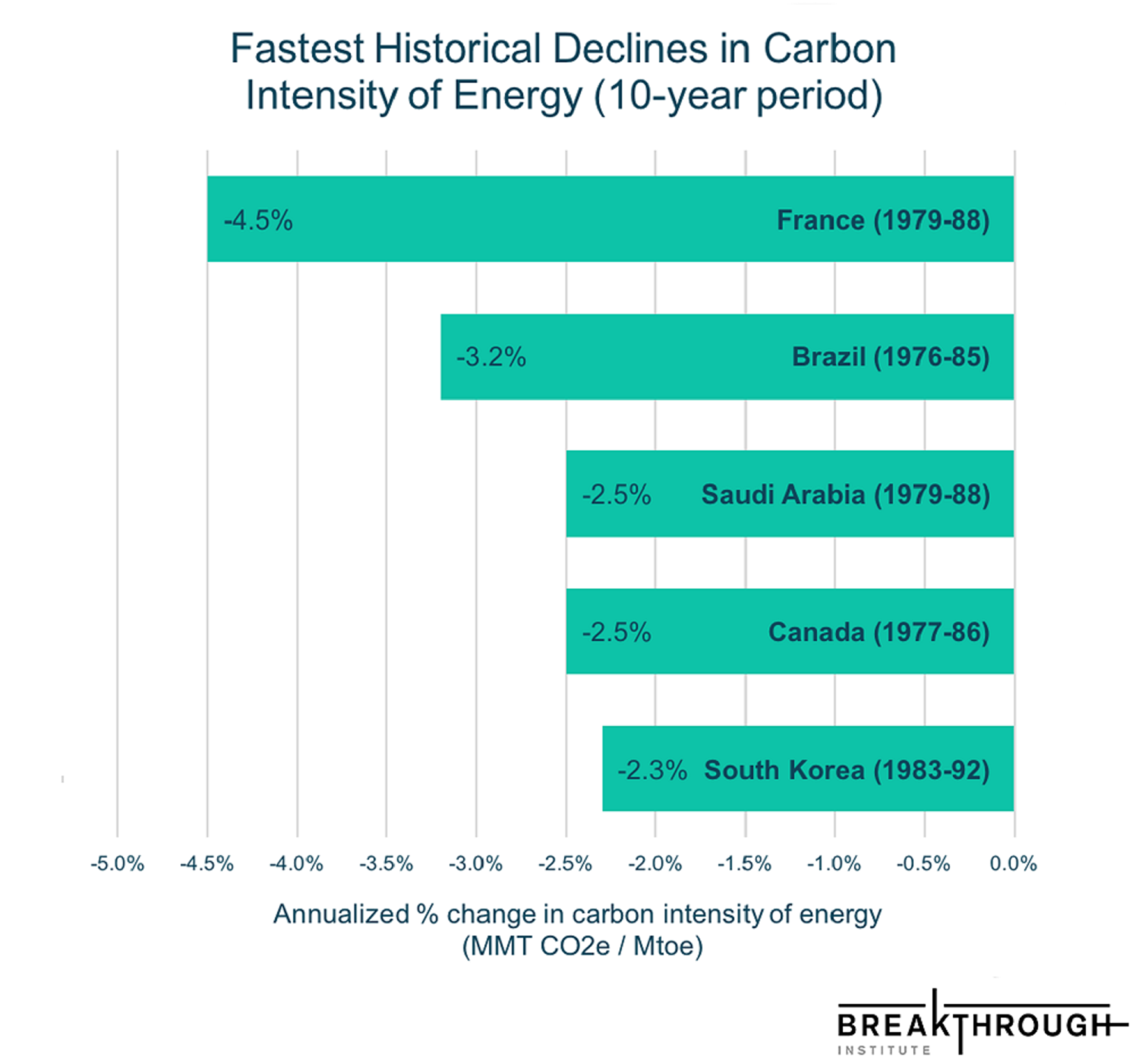The Green New Deal and the Legacy of Public Power
-
-
Share
-
Share via Twitter -
Share via Facebook -
Share via Email
-
A few weeks after her election to Congress, Rep.-elect Alexandria Ocasio-Cortez (D-NY) upended American climate politics by proposing a Green New Deal. Climate advocates on the left have long searched for a concise, ambitious policy proposal to fight climate change — a sort of climate “Medicare for All.” The Green New Deal aims to be exactly that. But, surprisingly, it consists of relatively traditional, market-oriented policies that were favored by the Obama Administration. Advocates for the Green New Deal should be aware that the fastest decarbonization rates in world history have all occurred in systems with a very different model: centralized public power.
The substance of the Green New Deal remains relatively vague, since the proposed legislation would only create a committee that would then be tasked with crafting the actual policy. But the core ideas seem to be mostly in line with what most climate advocates and moderate Democratic policymakers — as well as Breakthrough — have endorsed for years. A federal mandate for 100% renewable electricity is a form of a federal Renewable Portfolio Standard, which was proposed in Congress as early as 2007. Due to the difficulties inherent in reaching 100% renewables, we prefer a version of the policy that includes all zero-carbon sources, like nuclear and carbon capture; my op-ed with Justin Gillis in The New York Times in August proposed a federal Clean Energy Standard. A leading report on the Green New Deal put out by the progressive policy group Data for Progress includes nuclear and CCS, so it looks like a federal Clean Energy Standard could well be part of the package. We can’t complain.
Most of the rest of the Green New Deal proposal also resembles Obama Administration priorities: building a smart grid, promoting energy efficiency, incentivizing decarbonization outside of the electric sector, funding research for carbon capture technology, and increasing federal support to drive green manufacturing and exports. The one novel aspect of the Green New Deal proposal is the inclusion of a federal job guarantee, an in-vogue labor market policy that would probably have a bigger impact — on budgets, politics, and outcomes — than all of the other policies in the Green New Deal put together.
In total, the Green New Deal seems aimed to shape labor and capital markets to reduce emissions and meet climate goals. While the policies are less obviously market-based than, for example, a carbon tax or cap-and-trade scheme, the proposal still assumes that private actors will do most of the work of decarbonization. In historical experience, though, this hasn’t happened. As Breakthrough has previously observed, the five fastest historical decarbonization rates over a ten-year period have all been achieved in nationalized and centralized energy systems (see figure below). The real “Medicare for All” for energy might be public power.

Each of the countries with the fastest historical declines in carbon intensity experienced a rapid clean energy transition led by the public sector. Four of the five countries achieved these declines primarily by building large-scale clean energy generating projects — nuclear reactors and hydroelectric dams. (Saudi Arabia transitioned from oil to natural gas.) In this period, South Korea, Canada, and France were all varieties of social democracies, which viewed the nationalized expansion of clean energy as an explicit political goal rooted in commitments to equality, prosperity, and sustainability.
It’s no coincidence that the fastest decarbonization rates occurred in centralized, state-dominated energy systems and have prominently featured nuclear and hydroelectric power. State-run energy sectors enable speed and scale, as public finance enables long-term capital-intensive projects with low financial uncertainty. South Korea rapidly expanded nuclear capacity in the nine-year period from 1983 to 1992, in a standardized and centralized fashion that led to nuclear construction getting cheaper over time — a stark contrast to the mostly privatized and unorganized nuclear buildout in the US and the resulting escalation in costs. In Canada, a collection of provincial state-owned utilities including Hydro-Québec, BC Hydro, and Ontario Hydro drove a massive expansion in hydroelectric and nuclear generation. The nuclear plants built in Ontario include the largest nuclear power plant in the world, and continue to provide a majority of the province’s electricity. Meanwhile, in Brazil, the US-backed dictatorship built a massive series of hydroelectric generators in the 1970s and 1980s, including the largest hydroelectric dam in the world at the time. And, finally, France is a global leader in nuclear power. The French nuclear fleet — construction of which peaked from the 1970s to the 1980s — continues to supply about three-quarters of France’s electricity today. Public finance and public power worked together to drive these energy transitions through long-term investment in large-scale nuclear and hydroelectric generation.
Past American experience tells a similar story. The federal (i.e. nationalized) power agencies created in the New Deal era, like the Bonneville Power Administration and the Tennessee Valley Authority, substantially expanded emissions-free generation. Today, the BPA operates one of the lowest-carbon grids in the US, thanks to its large supply of hydro. Meanwhile, the TVA today is 37% nuclear — a plurality among its energy sources — and owns nearly one-tenth of the operating nuclear reactors in the US. Beyond these headline statistics, federal power agencies played a crucial role in the electrification and development of rural America during and after the Great Depression. Public power, when properly managed and deployed, can create benefits that extend far beyond the wires.
The environmental movement has traditionally been skeptical of scale and centralization, thanks to its ideological roots in post-material liberalism. But scale and centralization seem conducive — if not necessary — to achieving rapid energy transitions. These issues are especially clear in debates around global development, where small-scale “energy access” projects (like solar lamps) are often favored by Western donors over large-scale projects (like dams and nuclear reactors) that could reduce energy poverty more substantially. In the US, environmentalists like Amory Lovins have long argued for a “soft energy path” that would prioritize efficiency and localism. But the empirical record is unimpeachable — all of the countries with the fastest historical decarbonization rates took advantage of centralization, abundance, and scale.
Expectations for a Green New Deal must be tempered by current political realities. Getting any sort of climate policy through a divided Congress and an openly hostile administration would be a tremendous achievement, and advocates should not make the perfect the enemy of the good. But the core of the success of the “Medicare for All” campaign has been to remind people what the public sector can do, and the Green New Deal can do the same. This effort may be viable at first on smaller scales — for example, the burgeoning movement to bring Pacific Gas and Electric, the private utility here in Northern California, under public state control. Regardless, the legacy of public power cannot be forgotten. Public investments in clean energy decades ago continue to help the climate, as they will for decades to come.
Main image: Construction of the Bonneville Dam by the federal Bonneville Power Authority in 1934. Source: Wikimedia.
Keep the conversation going on Twitter. I'm @jamesonmcb and we're @TheBTI.


